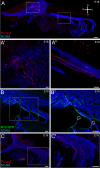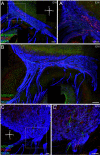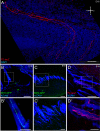Axon fasciculation in the developing olfactory nerve
- PMID: 20723208
- PMCID: PMC2936880
- DOI: 10.1186/1749-8104-5-20
Axon fasciculation in the developing olfactory nerve
Abstract
Olfactory sensory neuron (OSN) axons exit the olfactory epithelium (OE) and extend toward the olfactory bulb (OB) where they coalesce into glomeruli. Each OSN expresses only 1 of approximately 1,200 odor receptors (ORs). OSNs expressing the same OR are distributed in restricted zones of the OE. However, within a zone, the OSNs expressing a specific OR are not contiguous - distribution appears stochastic. Upon reaching the OB the OSN axons expressing the same OR reproducibly coalesce into two to three glomeruli. While ORs appear necessary for appropriate convergence of axons, a variety of adhesion associated molecules and activity-dependent mechanisms are also implicated. Recent data suggest pre-target OSN axon sorting may influence glomerular convergence. Here, using regional and OR-specific markers, we addressed the spatio-temporal properties associated with the onset of homotypic fasciculation in embryonic mice and assessed the degree to which subpopulations of axons remain segregated as they extend toward the nascent OB. We show that immediately upon crossing the basal lamina, axons uniformly turn sharply, usually at an approximately 90° angle toward the OB. Molecularly defined subpopulations of axons show evidence of spatial segregation within the nascent nerve by embryonic day 12, within 48 hours of the first OSN axons crossing the basal lamina, but at least 72 hours before synapse formation in the developing OB. Homotypic fasciculation of OSN axons expressing the same OR appears to be a hierarchical process. While regional segregation occurs in the mesenchyme, the final convergence of OR-specific subpopulations does not occur until the axons reach the inner nerve layer of the OB.
Figures










Similar articles
-
Requirement for Slit-1 and Robo-2 in zonal segregation of olfactory sensory neuron axons in the main olfactory bulb.J Neurosci. 2007 Aug 22;27(34):9094-104. doi: 10.1523/JNEUROSCI.2217-07.2007. J Neurosci. 2007. PMID: 17715346 Free PMC article.
-
Dishevelled proteins are associated with olfactory sensory neuron presynaptic terminals.PLoS One. 2013;8(2):e56561. doi: 10.1371/journal.pone.0056561. Epub 2013 Feb 20. PLoS One. 2013. PMID: 23437169 Free PMC article.
-
Odorant receptors regulate the final glomerular coalescence of olfactory sensory neuron axons.Proc Natl Acad Sci U S A. 2015 May 5;112(18):5821-6. doi: 10.1073/pnas.1417955112. Epub 2015 Apr 20. Proc Natl Acad Sci U S A. 2015. PMID: 25902488 Free PMC article.
-
Odorant receptor gene choice and axonal projection in the mouse olfactory system.Results Probl Cell Differ. 2009;47:57-75. doi: 10.1007/400_2008_3. Results Probl Cell Differ. 2009. PMID: 19083127 Review.
-
Basic principles and molecular mechanisms of olfactory axon pathfinding.Cell Tissue Res. 1997 Nov;290(2):457-63. doi: 10.1007/s004410050953. Cell Tissue Res. 1997. PMID: 9321710 Review.
Cited by
-
Eye-specific segregation and differential fasciculation of developing retinal ganglion cell axons in the mouse visual pathway.J Comp Neurol. 2018 May 1;526(7):1077-1096. doi: 10.1002/cne.24392. Epub 2018 Feb 1. J Comp Neurol. 2018. PMID: 29322522 Free PMC article.
-
Effects of prenatal alcohol exposure on the olfactory system development.Front Neural Circuits. 2024 May 15;18:1408187. doi: 10.3389/fncir.2024.1408187. eCollection 2024. Front Neural Circuits. 2024. PMID: 38818309 Free PMC article. Review.
-
Axon Fasciculation, Mediated by Transmembrane Semaphorins, Is Critical for the Establishment of Segmental Specificity of Corticospinal Circuits.J Neurosci. 2023 Aug 9;43(32):5753-5768. doi: 10.1523/JNEUROSCI.0073-22.2023. Epub 2023 Jun 21. J Neurosci. 2023. PMID: 37344234 Free PMC article.
-
An Evolutionary Microcircuit Approach to the Neural Basis of High Dimensional Sensory Processing in Olfaction.Front Cell Neurosci. 2021 Apr 30;15:658480. doi: 10.3389/fncel.2021.658480. eCollection 2021. Front Cell Neurosci. 2021. PMID: 33994949 Free PMC article.
-
Wired for behaviors: from development to function of innate limbic system circuitry.Front Mol Neurosci. 2012 Apr 26;5:55. doi: 10.3389/fnmol.2012.00055. eCollection 2012. Front Mol Neurosci. 2012. PMID: 22557946 Free PMC article.
References
-
- Bozza T, Vassalli A, Fuss S, Zhang JJ, Weiland B, Pacifico R, Feinstein P, Mombaerts P. Mapping of class I and class II odorant receptors to glomerular domains by two distinct types of olfactory sensory neurons in the mouse. Neuron. 2009;61:220–233. doi: 10.1016/j.neuron.2008.11.010. - DOI - PMC - PubMed
Publication types
MeSH terms
Substances
Grants and funding
LinkOut - more resources
Full Text Sources
Molecular Biology Databases
Miscellaneous

